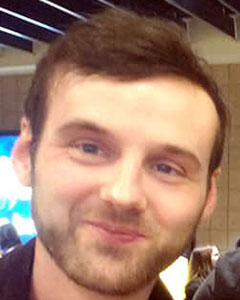HOW CAN WE HELP YOU? Call 1-800-TRY-CHOP
In This Section
How Do Human Adenoviruses Assemble Infectious Progeny Particles?
The findings:
Researchers at Children’s Hospital of Philadelphia and the Perelman School of Medicine at the University of Pennsylvania answered a long-standing, confounding scientific question by revealing the complex assembly process involved in adenovirus replication. In a new study published in Nature, they show that viral proteins use a process called phase separation to coordinate production of viral progeny.
Why it matters
Viruses hijack host cellular processes to replicate and produce infectious offspring that are essential for viral spread and transmission. To do this, viruses must both replicate their viral genomes and package those genomes into viral particles, so that the infectious cycle can continue. However, little was known about how genome replication, particle assembly, and genome packaging are spatially coordinated in the crowded nuclear environment.
Emerging evidence suggested that membraneless compartments form inside virus-infected cells by phase separation — spontaneous separation into two phases: dense and light. These membraneless compartments, known as biomolecular condensates (BMCs), can regulate biological processes by concentrating or sequestering biomolecules in the enriched dense phase, while limiting their concentration in the light phase. Although BMCs have been linked to several viral processes, there was insufficient evidence that phase separation contributes functionally to the assembly of infectious viral offspring in infected cells — until now.
These findings have broad implications, from potential therapeutic interventions to improved gene therapy delivery, in addition to expanding scientists’ understanding of basic cell biology.
Who conducted the study

Matthew Weitzman, PhD
Among the CHOP researchers was senior author Matthew Weitzman, PhD, an investigator and professor in CHOP’s Department of Pathology and Laboratory Medicine and first author Matthew Charman, PhD, a research associate in the Weitzman Lab.
How they did it
To investigate the potential role of BMCs in this process, the researchers studied adenovirus, a nuclear-replicating DNA virus. Because the adenovirus proteins involved in genome replication are distinct from those involved in particle assembly and genome packaging, the researchers reasoned focusing on this virus would allow them to dissect and more easily identify the role of phase separation in specific viral processes.

Matt Charman, PhD
Through a variety of techniques, including homopropargylglycine (HPG) labeling and fluorophore click chemistry, the researchers demonstrated that the adenovirus 52 kDa protein — a dedicated assembly/packaging protein — makes its own membraneless structures through phase separation and plays a critical role in the coordinated assembly of new infectious particles. They showed that not only does the 52 kDa protein organize viral capsid proteins into nuclear BMCs, but also that this organization is essential for the assembly of complete, packaged particles containing viral genomes.
The researchers also performed experiments with a mutant adenovirus lacking the 52 kDa protein and showed that incomplete capsids formed in the absence of viral BMCs, showing that by altering the formation of these membraneless structures within the cell, the “assembly line” producing viral offspring no longer functioned properly.
Quick thoughts
“If we think of viral replication as an old-fashioned milk assembly line, we know how the milk bottles (viral particle) are formed and that they come out filled (with viral genome), but prior to this study, the process of filling them was somewhat of a black box,” Dr. Weitzman said. “Our findings suggest that the viral particle forms around the viral genome. Extending this analogy, many have assumed that the bottle must be made before being filled, but it turns out the bottle (viral particle) is actually formed around the milk (viral genome). Led by Dr. Charman, we have shown that a biophysical process known as phase separation allows this process to occur in an orderly, coordinated fashion.”
By understanding how viruses are made, Dr. Charman ruminated on the possibilities of what could come next.
“This study answers a fundamentally important question: How a viral nucleic acid gets inside a particle so that viral offspring can be delivered to cells,” Dr. Charman said. “Now knowing these steps, the question becomes: Could we reengineer viruses based on this biological process to, for example, become better delivery vehicles for innovations like gene therapy? Understanding how viruses are made opens up a world where we could not only potentially target those viruses more effectively in the future but also create gene therapy tools that lack the limitations of current delivery approaches.”
Where the study was published
The study appeared in Nature. For more information, see CHOP News.



